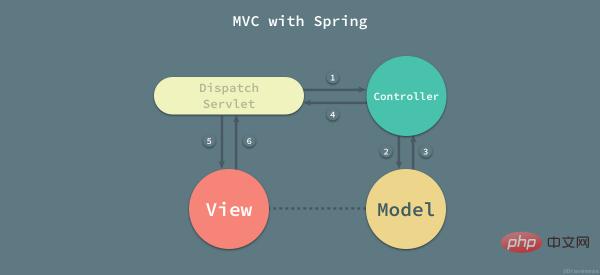What is the difference between mvc and mvvm
The difference between mvc and mvvm is: 1. The business processing modes are different. In MVC, View can directly access the Model, while MVVM is a mode that logically separates the page from the data. It puts the data binding work into Implement it in a JS; 2. The processing of data operations is different. MVVM displays the view layer through data rather than node operations.

What is the difference between mvc and mvvm:
The biggest difference between MVVM and MVC is: baiMVVM implements View and The automatic synchronization of the Model means that when the attributes of the Model change, we no longer need to manually operate the Dom element to change the display of the View. Instead, after changing the attribute, the display of the View layer corresponding to the attribute will automatically change. Very magical~
MVC, MVP, and MVVM are three common front-end architecture patterns (Architectural Pattern), which improve code organization by separating concerns. Different from Design Pattern, which is an abstract method summarized to solve a type of problem, an architectural pattern can often use multiple design patterns.
MVC mode is the basis of MVP and MVVM modes. These two modes are more like optimized and improved versions of MVC mode. The MVs of the three of them are Model and view are the same. The difference is the link between MVs. .

Extension content:
The full name of MVC is Model View Controller, which is model-view-control The abbreviation of controller is a software design paradigm that organizes code in a way that separates business logic, data, and interface display, and gathers business logic into a component to improve and personalize the interface and user interaction. , no need to rewrite business logic. MVC was uniquely developed to map traditional input, processing, and output functions into a logical graphical user interface structure.
MVVM is essentially an improved version of MVC. MVVM abstracts the state and behavior of the View, allowing us to separate the view UI and business logic. Of course, ViewModel has already done these things for us. It can take out the Model data and help handle the business logic involved in the View that needs to display content.
Microsoft's WPF brings new technical experiences, such as Silverlight, audio, video, 3D, animation..., which results in the software UI layer being more detailed and customizable. At the same time, at the technical level, WPF also brings new features such as Binding, Dependency Property, Routed Events, Command, DataTemplate, ControlTemplate and so on.
The origin of the MVVM (Model-View-ViewModel) framework is a new architectural framework that evolved from the application method of combining the MVP (Model-View-Presenter) mode with WPF. It is based on the original MVP framework and incorporates the new features of WPF to cope with increasingly complex changes in customer needs.
The above is the detailed content of What is the difference between mvc and mvvm. For more information, please follow other related articles on the PHP Chinese website!

Hot AI Tools

Undresser.AI Undress
AI-powered app for creating realistic nude photos

AI Clothes Remover
Online AI tool for removing clothes from photos.

Undress AI Tool
Undress images for free

Clothoff.io
AI clothes remover

AI Hentai Generator
Generate AI Hentai for free.

Hot Article

Hot Tools

Notepad++7.3.1
Easy-to-use and free code editor

SublimeText3 Chinese version
Chinese version, very easy to use

Zend Studio 13.0.1
Powerful PHP integrated development environment

Dreamweaver CS6
Visual web development tools

SublimeText3 Mac version
God-level code editing software (SublimeText3)

Hot Topics
 PHP MVC Architecture: Building Web Applications for the Future
Mar 03, 2024 am 09:01 AM
PHP MVC Architecture: Building Web Applications for the Future
Mar 03, 2024 am 09:01 AM
Introduction In today's rapidly evolving digital world, it is crucial to build robust, flexible and maintainable WEB applications. The PHPmvc architecture provides an ideal solution to achieve this goal. MVC (Model-View-Controller) is a widely used design pattern that separates various aspects of an application into independent components. The foundation of MVC architecture The core principle of MVC architecture is separation of concerns: Model: encapsulates the data and business logic of the application. View: Responsible for presenting data and handling user interaction. Controller: Coordinates the interaction between models and views, manages user requests and business logic. PHPMVC Architecture The phpMVC architecture follows the traditional MVC pattern, but also introduces language-specific features. The following is PHPMVC
 An advanced guide to PHP MVC architecture: unlocking advanced features
Mar 03, 2024 am 09:23 AM
An advanced guide to PHP MVC architecture: unlocking advanced features
Mar 03, 2024 am 09:23 AM
The MVC architecture (Model-View-Controller) is one of the most popular patterns in PHP development because it provides a clear structure for organizing code and simplifying the development of WEB applications. While basic MVC principles are sufficient for most web applications, it has some limitations for applications that need to handle complex data or implement advanced functionality. Separating the model layer Separating the model layer is a common technique in advanced MVC architecture. It involves breaking down a model class into smaller subclasses, each focusing on a specific functionality. For example, for an e-commerce application, you might break down the main model class into an order model, a product model, and a customer model. This separation helps improve code maintainability and reusability. Use dependency injection
 How to implement the MVC pattern using PHP
Jun 07, 2023 pm 03:40 PM
How to implement the MVC pattern using PHP
Jun 07, 2023 pm 03:40 PM
The MVC (Model-View-Controller) pattern is a commonly used software design pattern that can help developers better organize and manage code. The MVC pattern divides the application into three parts: Model, View and Controller, each part has its own role and responsibilities. In this article, we will discuss how to implement the MVC pattern using PHP. Model A model represents an application's data and data processing. usually,
 Uncovering the success of the SpringMVC framework: why it is so popular
Jan 24, 2024 am 08:39 AM
Uncovering the success of the SpringMVC framework: why it is so popular
Jan 24, 2024 am 08:39 AM
SpringMVC framework decrypted: Why is it so popular, specific code examples are needed Introduction: In today's software development field, the SpringMVC framework has become a very popular choice among developers. It is a Web framework based on the MVC architecture pattern, providing a flexible, lightweight, and efficient development method. This article will delve into the charm of the SpringMVC framework and demonstrate its power through specific code examples. 1. Advantages of SpringMVC framework Flexible configuration method Spr
 Developing MVC with PHP8 Framework: A Step-by-Step Guide
Sep 11, 2023 am 10:05 AM
Developing MVC with PHP8 Framework: A Step-by-Step Guide
Sep 11, 2023 am 10:05 AM
Developing MVC with PHP8 Framework: A Step-by-Step Guide Introduction: MVC (Model-View-Controller) is a commonly used software architecture pattern that is used to separate the logic, data and user interface of an application. It provides a structure that separates the application into three distinct components for better management and maintenance of the code. In this article, we will explore how to use the PHP8 framework to develop an application that conforms to the MVC pattern. Step One: Understand the MVC Pattern Before starting to develop an MVC application, I
 How to use MVC architecture to design projects in PHP
Jun 27, 2023 pm 12:18 PM
How to use MVC architecture to design projects in PHP
Jun 27, 2023 pm 12:18 PM
In Web development, MVC (Model-View-Controller) is a commonly used architectural pattern for processing and managing an application's data, user interface, and control logic. As a popular web development language, PHP can also use the MVC architecture to design and build web applications. This article will introduce how to use MVC architecture to design projects in PHP, and explain its advantages and precautions. What is MVCMVC is a software architecture pattern commonly used in web applications. MV
 From routing to views—an in-depth exploration of Beego's MVC architecture
Jun 23, 2023 am 10:53 AM
From routing to views—an in-depth exploration of Beego's MVC architecture
Jun 23, 2023 am 10:53 AM
Beego is a web application framework based on Go language, which has the advantages of high performance, simplicity and ease of use, and high scalability. Among them, the MVC architecture is one of the core design concepts of the Beego framework. It can help developers better manage and organize code, improve development efficiency and code quality. This article will delve into Beego's MVC architecture so that developers can better understand and use the Beego framework. 1. Introduction to MVC architecture MVC, or Model-View-Controller, is a common
 Detailed explanation of Spring MVC: in-depth analysis of this powerful framework
Dec 29, 2023 am 08:09 AM
Detailed explanation of Spring MVC: in-depth analysis of this powerful framework
Dec 29, 2023 am 08:09 AM
SpringMVC is a very popular JavaWeb development framework, which is widely welcomed for its powerful functions and flexibility. Its design idea is based on the MVC (Model-View-Controller) architectural pattern, which achieves decoupling and modularization of the application by dividing the application into three parts: model, view and controller. In this article, we will delve into various aspects of the SpringMVC framework, including request processing and forwarding, model and view processing,






